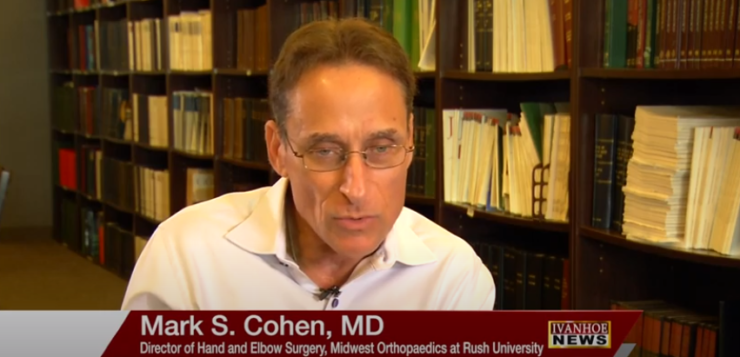Mark Cohen, MD, Director of Hand and Elbow Surgery, Midwest Orthopedics at Rush University Medical Center talks about arthroplasty thumb surgery in the treatment of thumb arthritis.
How common of an issue is thumb arthritis?
Dr. Cohen: Thumb arthritis is the number one reason that middle age women come to see hand doctors. The most common presentation we see in the office are people having symptoms of early thumb arthritis. It turns out the thumb is the most important of all the digits, and it has the most mobility. It rotates, and it twists. The joint that connects the thumb to the wrist is extremely complex and has a tremendous amount of mobility and stability. If you pinch 10 pounds, you put 100 pounds of load through that joint because of the lever arm. So, the design of the thumb is beautiful, but it wears out. The cartilage on the thumb’s surface, with normal activities, can thin and that leads to arthritis, and that brings people to see us. It is in both men and women, but it is more common in women.
Why is it more common in women?
Dr. Cohen: It is not activity-related necessarily. Much like running does not cause knee arthritis, using your hands does not cause thumb arthritis. There are a lot of factors we do not understand. There is clearly a genetic predisposition, often passed down from mother to daughter. We are not sure why women are more prone to thumb arthritis but there are a lot of theories. Women are more loose-jointed, so their joints rotate, move, and shear more than men. That may lead to more stress and thinning on the cartilage. So, it is not fully understood, but it is clearly a condition seen more in females than in the male population.
Are there any other risk factors or causes?
Dr. Cohen: The most common joint in the body to be arthritic is the joint at the base of the finger nail, called the distal joint of the finger. The second most common arthritic joint in the body is the joint that connects the thumb to the wrist known as the basilar thumb joint. Again, we do not fully understand why it is more prevalent in women than men, there are just some theories.
What do you do to treat it?
Dr. Cohen: Education is important because people come in, they have pain, and they are worried that certain activities will make the condition worse or it will cause further degeneration. So, the most important thing is education. You cannot hurt yourself by using your hands. If you have thumb pain, you will not cause any damage using your thumb. You do not have to worry that if you overdo activity it will lead to worsening of the arthritis It is only pain, as you are not hurting the cartilage or causing future problems. Patients can be taught that there are ways to limit how you load your thumb. Using a fat pen, for example, decreases stress across the base of the thumb. In addition, there is an entire industry of kitchen utensils designed to not put stress on that thumb joint. So, education from a therapist can help, Then we have soft supports, such as neoprene, that do not limit motion or function but give support to the joint. This helps symptoms during activity. We often use a hard night brace. A brace that rests a joint during sleep can make it less symptomatic and be extremely helpful during the day. Of course, anti-inflammatory medications are useful and sometimes we give cortisone shots into the joint itself. But I would say 80% to 90% of people we can treat without surgery.
When do people need the surgery?
Dr. Cohen: People will know when they are ready, which means you do not need surgery if you are having minor symptoms. If you try all of the conservative modalities and you still cannot do the things you want to do, and you still have significant pain and functional problems, that is the time to consider the surgery. I like to say that the most miserable people going into surgery are the happiest people coming out. So, if you cannot do the things you want daily, that is the time to consider surgery.
Walk me through the surgery?
Dr. Cohen: Over the years there have been a lot of surgeries that have tried to treat the joint. Most of us still use the original reconstruction where the small bone that connects the thumb to the wrist is removed and rebuilt with one of the patient’s tendons, meaning we build a little hammock or a support for the thumb using a tendon so it is no longer rubbing on the bone but supported on a sling. So, the mobility of the thumb is good, the strength is good, and the pain is better.
What is the surgery called?
Dr. Cohen: It is called carpometacarpal joint arthroplasty, suspension-plasty, and some call it a tendon transfer. There are a lot of different terms, but it is a universally used soft tissue reconstruction of the thumb for arthritis.
Tell me what led Marcy to come to you?
Dr. Cohen: She had dealt with these symptoms for an awfully long time and had been treated with conservative measures. She got to the point where she could not live with her pain and even had trouble sleeping.
What is the recovery like and how long is the surgery?
Dr. Cohen: The surgery takes about 30 to 45 minutes. The recovery is not easy because we rebuild the thumb joint with the tendon, so you need to allow time for it to heal. After surgery, the patient is in a splint for a week, and then they have to go into a cast for three additional weeks. The month is required to allow the soft tissues to start to heal. Then patients are placed into a removable brace which they can take off and move their thumb around to loosen things up. But when they are not exercising or performing therapy, they are back in the brace to stabilize the joint and let it heal. But it does take time to fully recover, which is why I tell my patients, don’t have the surgery until you’re ready, because it can take three or four months before they start to feel like it’s their thumb again. It feels a little sore and a little stiff initially.
So, they are put under for the surgery?
Dr. Cohen: No, we do our surgeries by numbing the arm. We do what is called a block and they are in “twilight sleep,” Sometimes they, but they’re not under general anesthesia.
So, they could be awake and watch you doing it?
Dr. Cohen: They do not watch because we have a curtain for sterility which blocks them from the surgical area. But they can listen and be awake if they would like. Most people do not like to be awake. Most people are in what is called “twilight” and they sleepthrough the procedure.
How soon can they get back to their normal activities?
Dr. Cohen: They must allow at least a month for the soft tissues to heal and then they must be in a brace for another month. I would guess, two or three months to return to normal activities. Now, people who are avid golfers, for example, may take a bit longer.
How do you believe that this will change their quality of life?
Dr. Cohen: The thumb is involved in everything we do with our hands, including pinching, grasping, squeezing, and lifting. So, if you cannot use your hand because of your thumb, it is not functioning well. After surgery when it no longer hurts, they can use their hand for for everything they want.
Anything that I did not ask you that you feel that people should know?
Dr. Cohen: Thumb arthritis is becoming more prevalent because the population is aging and we are seeing more of these patients than we used to. To me, the most important thing is to let people know that it is nothing to worry about. They will most likely be able to be treated without the need for surgery. And the worst-case scenario is we have a remarkably successful and predictable surgery to make them better.
Is texting or typing on keyboards a contributor?
Dr. Cohen: The only thing that loads the thumb is heavy gripping and pinching. So, using the thumb for certain things like texting may make them a little bit symptomatic, but it does not cause or change the natural history of the thumb arthritis.
Interview conducted by Ivanhoe Broadcast News.
END OF INTERVIEW
This information is intended for additional research purposes only. It is not to be used as a prescription or advice from Ivanhoe Broadcast News, Inc. or any medical professional interviewed. Ivanhoe Broadcast News, Inc. assumes no responsibility for the depth or accuracy of physician statements. Procedures or medicines apply to different people and medical factors; always consult your physician on medical matters.
If you would like more information, please contact:
Ann Pitcher
Sign up for a free weekly e-mail on Medical Breakthroughs called First to Know by clicking here




